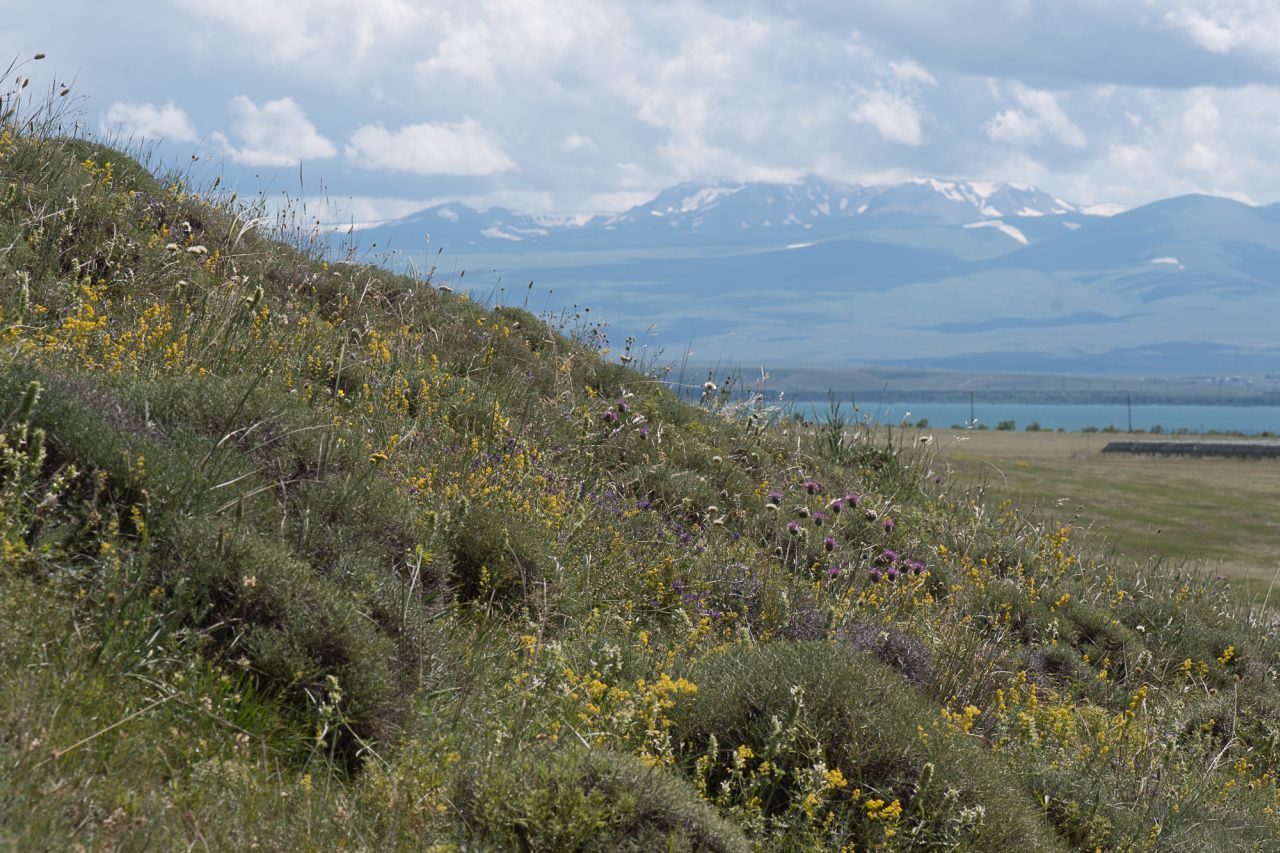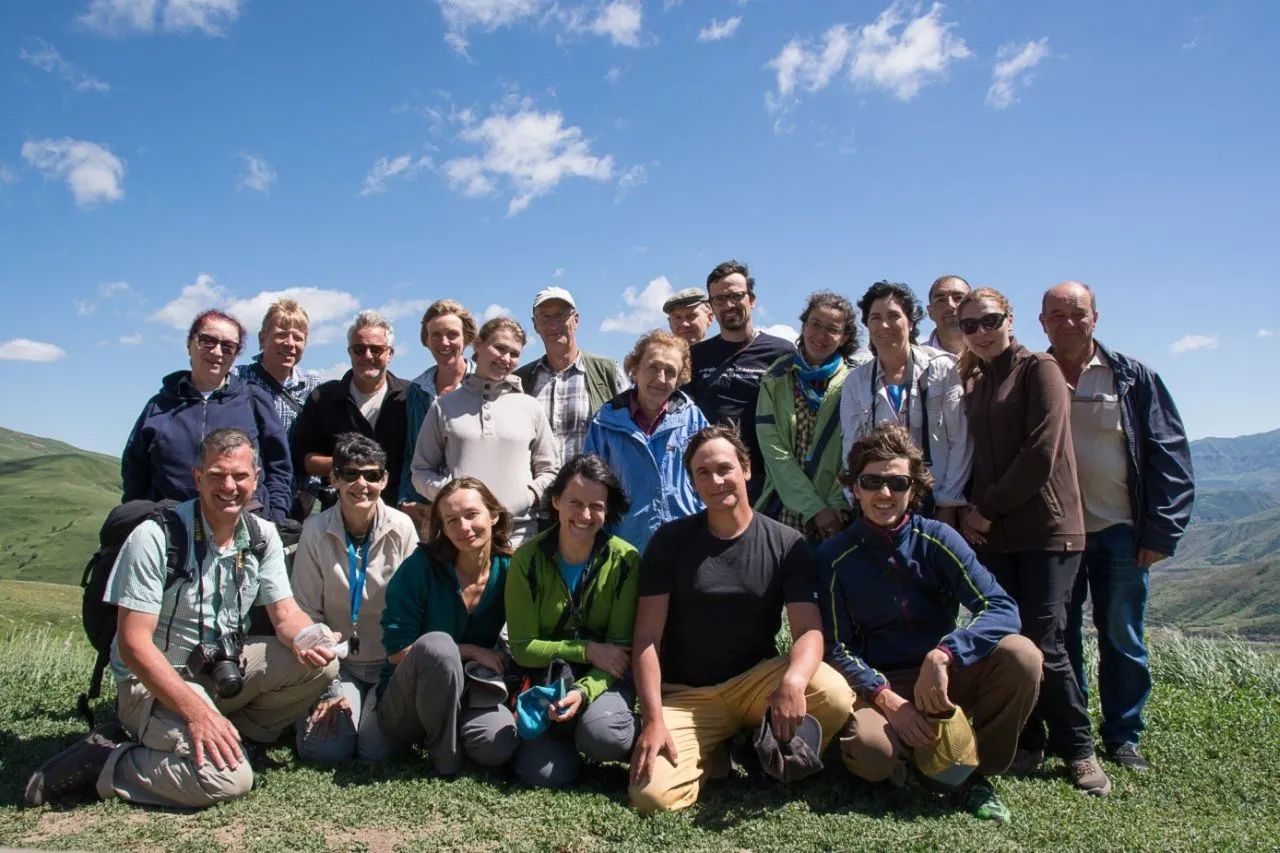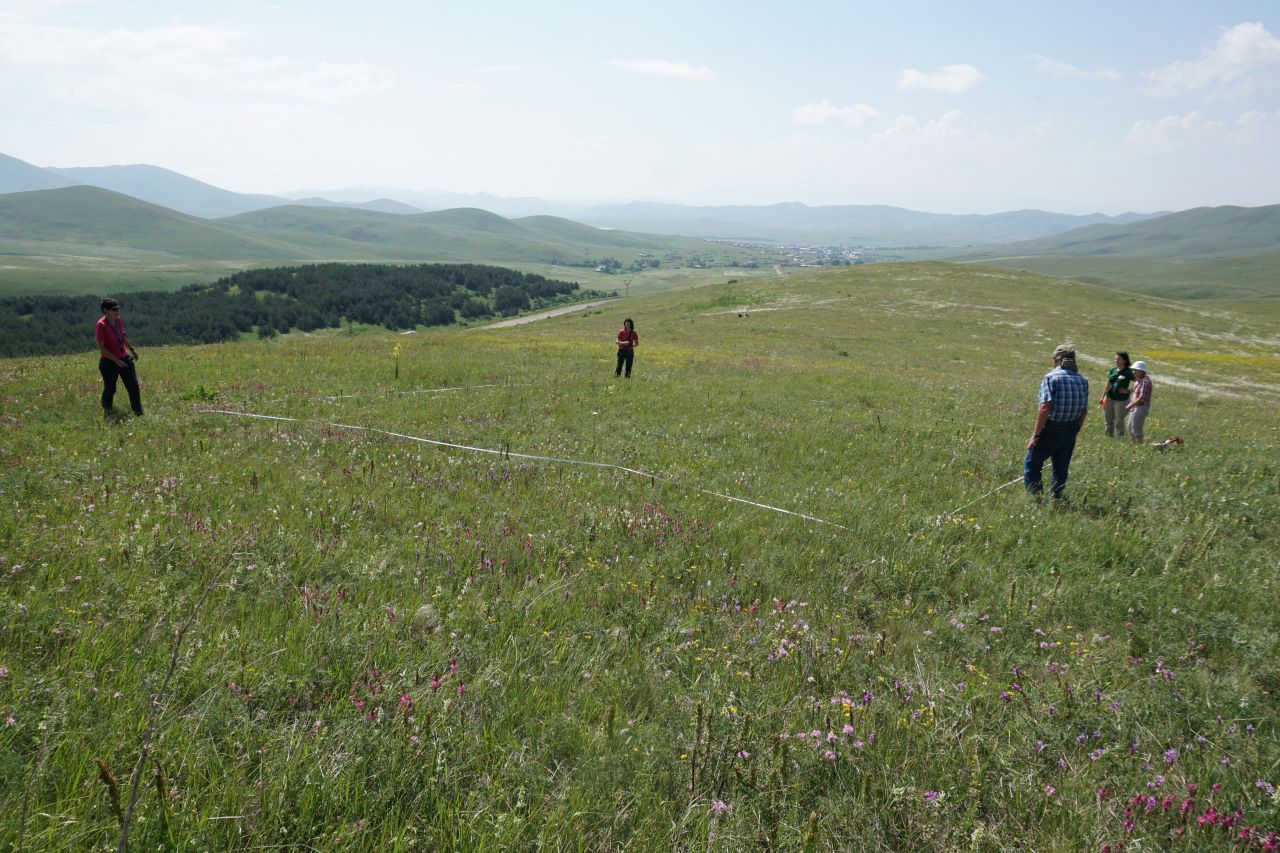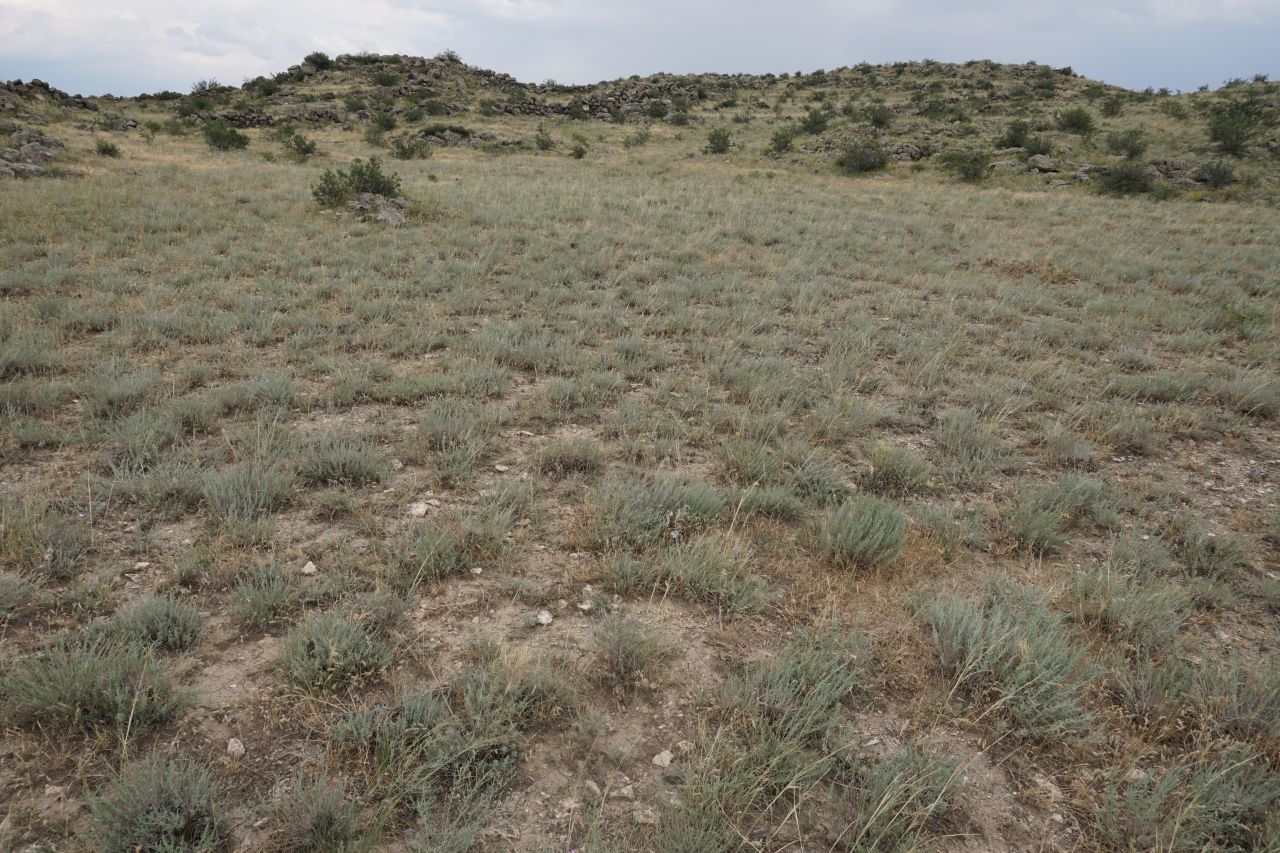The post provided by: Denys Vynokurov, Alla Aleksanyan, Idoia Biurrun & Jürgen Dengler
 Stand of the newly described dry grassland association Seslerio phleoidis-Onobrychidetum cornutae (class Festuco-Brometea) in Armenia. Photo credit: Jürgen Dengler
Stand of the newly described dry grassland association Seslerio phleoidis-Onobrychidetum cornutae (class Festuco-Brometea) in Armenia. Photo credit: Jürgen Dengler
Reference
This post refers to the article Dry grasslands and thorn-cushion communities of Armenia: a first syntaxonomic classification by Vynokurov et al. published in Vegetation Classification and Survey (https://doi.org/10.3897/VCS.119253) as part of the Special Collection “Grasslands of Asia”
IAVS’ Working Group EDGG (Eurasian Dry Grassland Group) initiated the Field Workshops in 2009, when the first such event took place in Transylvania, Romania, and already yielded some world records of alpha diversity (Dengler et al., 2012; Wilson et al., 2012). Since then, the Field Workshops have become the second major event of EDGG apart from the Eurasian Grassland Conferences (EGCs). One or two such international research expeditions are conducted every year, with the aim to collect high-quality biodiversity data initially of European dry grasslands, but meanwhile of a wide range of grassland and other non-forest habitat types across the Palaearctic. In June 2024, the 18th EDGG Field Workshop will take place in the dry valleys of the SW Alps. EDGG Field Workshops are specific in using a standardised multi-scale and multi-taxon sampling design, with eight standard grain sizes (0.0001-1,000 m2) on which vascular plants, bryophytes and lichens are carefully sampled for completeness, together with a standardised set of structural, topographic and soil variables (Dengler et al., 2016; Biurrun et al., 2019). For better data quality and to enable certain analyses like those of species-abundance distributions, species cover is always estimated in percent instead of an ordinal scale (Dengler & Dembicz, 2023). Sometimes also non-plant taxa are sampled in the same plots (Hilpold et al., 2020). EDGG Field Workshops have already given rise to numerous regional studies on biodiversity (e.g. Turtureanu et al., 2014; Dembicz et al., 2021a; Bergauer et al., 2022) and syntaxonomy (e.g. Dengler et al., 2012; García-Mijangos et al., 2021; Magnes et al., 2021). Moreover, they are the backbone of EDGG’s vegetation-plot database GrassPlot (Dengler et al., 2018) which enabled a series of high-impact papers (Dengler et al., 2020; Biurrun et al., 2021; Dembicz et al., 2021b; Ulrich et al., 2022) and is feeding the online GrassPlot Diversity Explorer.
 The expedition team on the Selim pass. Photo credit: Jürgen Dengler
The expedition team on the Selim pass. Photo credit: Jürgen Dengler
The 13th EDGG Field Workshop was devoted to the dry grasslands of Armenia. Armenia is a country of remarkable ecological diversity, given its relatively small size. The country is part of the Caucasus biodiversity hotspot. It is situated at the crossroads of several biogeographical regions, resulting in a high diversity of habitats and a rich vascular plant flora. Grasslands are found in every floristic region of Armenia. Despite their ecological importance and wide distribution, grasslands remained relatively understudied compared to other ecosystems such as forests. While Armenia has a rich history of vegetation research, including botanical exploration dating back centuries and classification of habitats, there are still only few phytosociological studies from the country, and none from grasslands. Likewise, the small-scale diversity patterns of Armenia were largely unknown before. Therefore, the Field Workshop had two main aims: (a) to analyse the biodiversity patterns of the Armenian grasslands across multiple taxonomic groups and grain sizes, and (b) to study the syntaxonomic position of these grasslands in a broad-scale context.
The Field Workshop took place from 26 June to 6 July 2019 and was attended by 19 people of all academic levels from nine countries (Armenia, Austria, Bulgaria, Germany, Italy, Russia, Spain, Switzerland and Ukraine) (for more detail, see Aleksanyan et al. 2020). Most participants were botanists, with two zoologists specialized in orthopteroid insects. Additionally, two cryptogam specialists determined bryophytes and lichens after the event. The sampling was designed to yield a comprehensive dataset encompassing both the flora and orthopteroid insects across diverse grassland habitats in different parts of the country. It involved 16 sites from seven floristic regions, across an elevational gradient from 1,338 to 2,400 m a.s.l. During 10 days, vascular plant, bryophyte and lichen data were collected by means of 29 EDGG Biodiversity Plots (nested-plot series of 0.0001 to 100 m²) and 53 10-m² plots. Data of orthopteroid insects (Orthoptera and Mantodea) were recorded in 42 100-m² plots. The workshop provided participants with wonderful insights into the diversity of the dry grasslands of Armenia, as well as the overall habitats and flora. During the field workshop, participants had the opportunity not only to encounter a variety of landscapes but also to visit different regions, become acquainted with diverse lifestyles, and explore the rich cultural heritage, including Armenian food and drinks.
 100-m2 EDGG Biodiversity Plot sampled in a mesoxeric grassland during the Field Workshop in Armenia. Photo credit: Dariia Borovyk
100-m2 EDGG Biodiversity Plot sampled in a mesoxeric grassland during the Field Workshop in Armenia. Photo credit: Dariia Borovyk
Four and a half years later, all the vascular plants, bryophytes and lichens were determined, soils analysed, and the data processed and analysed, and the first main paper from the Field Workshop was written by its participants. This paper has just been published in Vegetation Classification and Survey: The 111 10-m2 vegetation plots were classified into 12 associations and preliminary communities at association level. The unsupervised classification of the broad-scale dataset (our data from the Field Workshop in Armenia together with vegetation plots from the bordering countries) resulted in five main groups, which were used for the high-level syntaxonomical assignments. We included about half of the Armenian plots into the class Festuco-Brometea, while the remaining plots represent a potential new class, preliminarily called “Ziziphora tenuior-Stipa arabica grasslands”, in drier conditions with many Irano-Turanian elements. Most of the syntaxa were new to science, therefore we provided formal descriptions of three orders (Plantagini atratae-Bromopsietalia variegatae, Onobrychido transcaucasicae-Stipetalia pulcherrimae, Cousinio brachypterae-Stipetalia arabicae), four alliances (Acantholimono caryophyllacei-Stipion holosericeae, Artemision fragrantis, Onobrychido michauxii-Stipion capillatae, Onobrychido transcaucasicae-Stipion pulcherrimae) and six associations. Our study will thus lead to an improvement of the syntaxonomic system in the EuroVegChecklist (Mucina et al., 2016; online updates at https://floraveg.eu/vegetation/) for Transcaucasia, with the respective applications for changes being underway.
We found significant differences in the topographical, climatic, soil characteristics, structural parameters, life form spectra and distribution range types among the grassland types at all syntaxonomic levels. We recorded outstanding small-scale vascular plant diversity, with an average of 46.8 vascular plants in 10 m2, which was significantly richer than the Palaearctic average of similar vegetation types (see GrassPlot Diversity Explorer). This high alpha diversity of vascular plants contrasted with a surprisingly low diversity of bryophyte and lichen components. Interestingly, the opposite was found in dry grasslands of the central valleys of the Alps, i.e. below-average alpha diversity of vascular plants and above-average of non-vascular taxa (Bergauer et al., 2022). This could point on glaciations as a major driver of alpha diversity, with the flora of the fully glaciated Alps impoverished and that of the Caucasus not, where only the summits had glaciers.
There is a promising outlook for further studies in Armenia and neighbouring countries, particularly in the fields of biodiversity research and vegetation studies. Expanding upon the groundwork established by the participants of the expedition, future research can delve deeper into understanding vegetation classification at both regional and broader scales. This will enable broad-scale comparisons, not only within Transcaucasia but also across the entire Western Asian region, where classification systems are still largely idiosyncratic and inconsistent. Further, our collection of high-quality multiscale and multitaxon (vascular plants, bryophytes, lichens, orthopteroid insects) from Armenia will allow for an interesting study on patterns and drivers of biodiversity.
In conclusion, the Eurasian Dry Grassland Group (EDGG; https://edgg.org) and the GrassPlot database (https://edgg.org/databases/GrassPlot) are collaborative platforms, providing invaluable opportunities for collective contributions to the advancement of grassland research across the Palaearctic region through networking, knowledge exchange, and hands-on field experiences. Involvement in these networks will elevate local research efforts and facilitate the incorporation of local-scale studies into a global context.
 Stand of the newly described semi-desert community Noaeo mucronatae-Artemisietum fragrantis. We believe that it belongs to a hitherto undescribed class of Western Asian xeric communities, preliminarily called Ziziphora tenuior-Stipa arabica grasslands. Photo credit: Denys Vynokurov
Stand of the newly described semi-desert community Noaeo mucronatae-Artemisietum fragrantis. We believe that it belongs to a hitherto undescribed class of Western Asian xeric communities, preliminarily called Ziziphora tenuior-Stipa arabica grasslands. Photo credit: Denys Vynokurov
References:
- Aleksanyan, A., Biurrun, I., Belonovskaya, E., Cykowska-Marzencka, B., Berastegi, A., Hilpold, A. et al. (2020) Biodiversity of dry grasslands in Armenia: First results from the 13th EDGG Field Workshop in Armenia. Palaearctic Grasslands, 46, 12–51. https://vegsciblog.org/2020/09/04/high-diversity-in-armenian-grasslands-edgg-field-workshop/
- Bergauer, M., Dembicz, I., Boch, S., Willner, W., Babbi, M., Blank-Pachlatko, J. et al. (2022) Scale-dependent patterns and drivers of vascular plant, bryophyte and lichen diversity in dry grasslands of the Swiss inneralpine valleys. Alpine Botany, 132, 195–209. https://doi.org/10.1007/s00035-022-00285-y
- Biurrun, I., Burrascano, S., Dembicz, I., Guarino, R., Kapfer, J., Pielech, R. et al. (2019) GrassPlot v. 2.00 – first update on the database of multi-scale plant diversity in Palaearctic grasslands. Palaearctic Grasslands, 44, 26–47. https://doi.org/10.21570/EDGG.PG.44.26-47
- Biurrun, I., Pielech, R., Dembicz, I., Gillet, F., Kozub, L., Marcenò, C. et al. (2021) Benchmarking plant diversity of Palaearctic grasslands and other open habitats. Journal of Vegetation Science_,_ 32, e13050. https://doi.org/10.1111/jvs.13050, https://vegsciblog.org/2021/08/04/grassplot-marathon-richness-of-palaearctic-grasslands/
- Dembicz, I., Velev, N., Boch, S., Janišová, M., Palpurina, S., Pedashenko, H. et al. (2021a) Drivers of plant diversity in Bulgarian dry grasslands vary across spatial scales and functional-taxonomic groups. Journal of Vegetation Science, 32, e12935. https://doi.org/10.1111/jvs.12935
- Dembicz, I., Dengler, J., Steinbauer, M.J., Matthews, T.J., Bartha, S., Burrascano, S. et al. (2021b) Fine-grain beta diversity of Palaearctic grassland vegetation. Journal of Vegetation Science, 32, e13045. https://doi.org/10.1111/jvs.13045, https://vegsciblog.org/2022/01/24/fine-grain-beta-diversity-in-palaearctic-open-vegetation/
- Dengler, J. & Dembicz, I. (2023) Should we estimate plant cover in percent or on ordinal scales? Vegetation Classification and Survey, 4, 131–138. https://doi.org/10.3897/VCS.98379, https://vegsciblog.org/2023/08/14/should-we-estimate-plant-cover-in-percent-or-on-ordinal-scales/
- Dengler, J., Becker, T., Ruprecht, E., Szabó, A., Becker, U., Beldean, M. et al. (2012) Festuco-Brometea communities of the Transylvanian Plateau (Romania) – a preliminary overview on syntaxonomy, ecology and biodiversity. Tuexenia, 32, 319–359.
- Dengler, J., Boch, S., Filibeck, G., Chiarucci, A., Dembicz, I., Guarino, R. et al. (2016) Assessing plant diversity and composition in grasslands across spatial scales: the standardised EDGG sampling methodology. Bulletin of the Eurasian Dry Grassland Group, 32, 13−30.
- Dengler, J., Wagner, V., Dembicz, I., García-Mijangos, I., Naqinezhad, A., Boch, S. et al. (2018) GrassPlot – a database of multi-scale plant diversity in Palaearctic grasslands. Phytocoenologia, 48, 331–347. https://doi.org/10.1127/phyto/2018/0267
- Dengler, J., Matthews, T.J., Steinbauer, M.J., Wolfrum, S., Boch, S., Chiarucci, A. et al. (2020) Species-area relationships in continuous vegetation: Evidence from Palaearctic grasslands. Journal of Biogeography, 47, 72–86. https://doi.org/10.1111/jbi.13697
- García-Mijangos, I., Berastegi, A., Biurrun, I., Dembicz, I., Janišová, M., Kuzemko, A. et al. (2021) Grasslands of Navarre (Spain), focusing on the Festuco-Brometea: classification, hierarchical expert system and characterisation. Vegetation Classification and Survey, 2, 195–231. https://doi.org/10.3897/VCS/2021/69614, https://vegsciblog.org/2022/03/05/semi-supervised-classification-navarran-grasslands/
- Hilpold, A., Kirschner, P. & Dengler, J. (2020) Proposal for a standardized surveying methodology for orthopteroid insects. Palaearctic Grasslands, 46, 42–57. https://doi.org/10.21570/EDGG.PG.46.52-57
- Magnes, M., Willner, W., Janišová, M., Mayrhofer, H., Afif Khouri, E., Berg, C. et al. (2021) Xeric grasslands of the inner-alpine dry valleys of Austria – new insights into syntaxonomy, diversity and ecology. Vegetation Classification and Survey, 2, 133–157. https://doi.org/10.3897/VCS/2021/68594
- Mucina, L., Bültmann, H., Dierßen, K., Theurillat, J.-P., Raus, T., Čarni, A. et al. (2016) Vegetation of Europe: Hierarchical floristic classification system of vascular plant, bryophyte, lichen, and algal communities. Applied Vegetation Science, 19, Supplement 1: 3−264. https://doi.org/10.1111/avsc.12257
- Turtureanu, P.D., Palpurina, S., Becker, T., Dolnik, C., Ruprecht, E., Sutcliffe, L.M.E. et al. (2014) Scale-and taxon-dependent biodiversity patterns of dry grassland vegetation in Transylvania. Agriculture, Ecosystems & Environment, 182, 15–24. https://doi.org/10.1016/j.agee.2013.10.028
- Ulrich, W., Matthews, T.J., Biurrun, I., Campos, J.A., Czortek, P., Dembicz, I. et al. (2022) Environmental drivers and spatial scaling of species abundance distributions in Palaearctic grassland vegetation. Ecology, 103, e3725. https://doi.org/10.1002/ecy.3725
- Wilson, J.B., Peet, R.K., Dengler, J. & Pärtel, M. (2012) Plant species richness: the world records. Journal of Vegetation Science, 23, 796−802. https://doi.org/10.1111/j.1654-1103.2012.01400.x
